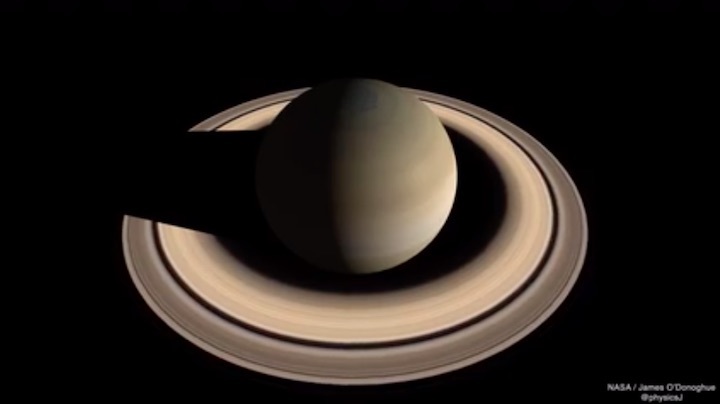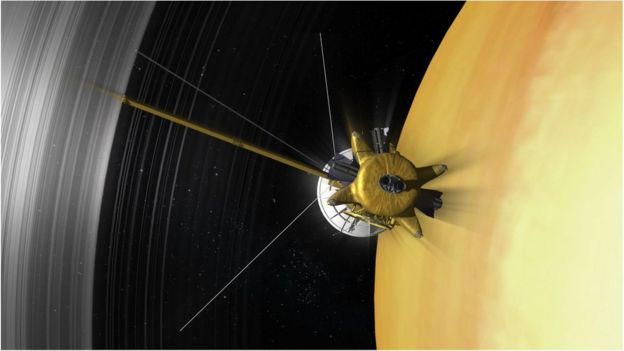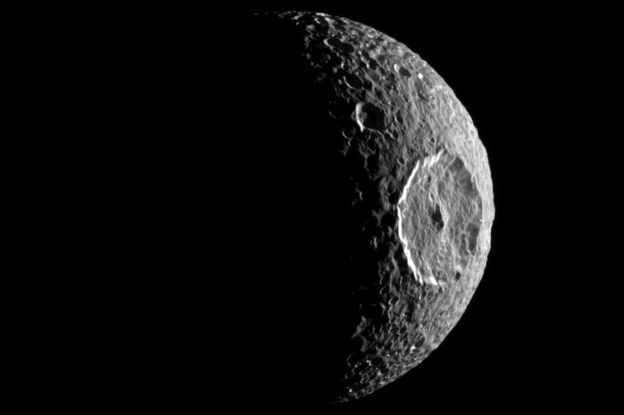18.01.2019
Scientists say Saturn spent billions of years _ almost its entire existence _ without its stunning rings

Saturn may have flown solo for billions of years — almost its entire existence — before getting its stunning set of rings, a new study suggests.
An Italian-led team reported Thursday in the journal Science that Saturn's primary rings appear to be just 10 million to 100 million years old. The gas giant Saturn, on the other hand, is 4.5 billion years old, like all the other planets in our solar system.
The findings are based on data collected by NASA's Cassini spacecraft while repeatedly diving between Saturn and its rings in 2017, shortly before its demise.
By estimating the mass of the rings through gravity measurements, the researchers gauged the age of the three main rings: A, B and C. It's still a mystery, though, how these icy rings formed. Scientists suspect a collision between two of Saturn's many moons or perhaps a moon and comet.
The rings are made mostly of ice. The remaining 1 percent is dust and possibly organic contaminants. Overall, the material ranges in size from tiny particles, to pebbles, to boulders.
Lead researcher Luciano Iess, a planetary scientist at Sapienza University in Rome, said orbital motion sprayed the dust and other contaminants onto the icy rings at a constant rate. His team calculated the length of time it would take for the contaminants to accumulate — it turned out to be a "short" 10 million to 100 million years.
It's possible the rings originally were denser than they are now and have thinned over time, which would put them more in line with Saturn's age. But Iess said there's little consensus for that theory.
Iess said NASA's Voyager spacecraft — as well as Cassini — had already provided clues that the rings had not formed with Saturn. "But now we have much more concrete evidence, which was only possible to obtain during the final phase of the mission, called the Grand Finale," he wrote in an email.
The only spacecraft to ever orbit Saturn, Cassini burned up as it plunged through the planet's atmosphere.
The masses of Saturn's fainter D, F, G and E rings are considered negligible, the researchers wrote.
Saturn's E ring, meanwhile, has its own unique source: plumes of water vapor streaming into space from the moon Enceladus, believed to harbor an ocean beneath its surface.
Iess noted the latest findings are "another gift we received from this beautiful mission."
"Cassini, like all giants, has left a legacy that will last for a long time," he said.
Cassini was launched from Florida in 1997. It carried the European probe named Huygens, which separated and landed on Saturn's moon Titan in 2005.
Quelle: abcNews
+++
Saturn's spectacular rings are 'very young'
We're looking at Saturn at a very special time in the history of the Solar System, according to scientists.
They've confirmed the planet's iconic rings are very young - no more than 100 million years old, when dinosaurs still walked the Earth.
The insight comes from the final measurements acquired by the American Cassini probe.
The satellite sent back its last data just before diving to destruction in the giant world's atmosphere in 2017.
"Previous estimates of the age of Saturn's rings required a lot of modelling and were far more uncertain. But we now have direct measurements that allows us to constrain the age very well," Luciano Iess from Sapienza University of Rome, Italy, told BBC News.
The professor's team has published an account of its work with Cassini in Science magazine.
Cassini: A mission of 'astonishing discovery'
There has long been a debate about the age of Saturn's rings. Some had argued these gorgeous loops of icy particles most likely formed along with the planet itself, some 4.5 billion years ago.
Others had suggested they were a recent phenomenon - perhaps the crushed up remains of a moon or a passing comet that was involved in a collision.
 Image copyrightNASA
Image copyrightNASA
The US-European Cassini mission promised to resolve the argument in its last months at the gas giant.
The satellite's end days saw it fly repeatedly through the gap between the rings and the planet's cloudtops.
These manoeuvres made possible unprecedented gravity measurements.
Cassini essentially weighed the rings, and found their mass to be 20 times smaller than previous estimates: something on the order of 15,400,000,000,000,000 tonnes, or about two-fifths the mass of Mimas - the Saturn moon that looks like the "Death Star" weapon in the Star Wars movies.
 Image copyrightCASSINI IMAGING TEAM/SSI/JPL/ESA/NASA
Image copyrightCASSINI IMAGING TEAM/SSI/JPL/ESA/NASA
Knowing the mass was a key piece in the puzzle for researchers.
From Cassini's other instruments, they already knew the proportion of dust in the rings and the rate at which this dust was being added. Having a definitive mass for the rings then made it possible to work out an age.
Prof Iess's team says this could be as young as 10 million years but is no older than 100 million years. In terms of the full age of the Solar System, this is "yesterday".
The calculation agrees with one made by a different group which last month examined how fast the ring particles were falling on to Saturn - a rate that was described as being equivalent to an Olympic-sized swimming pool every half-hour.
This flow, when all factors were considered, would probably see the rings disappear altogether in "at most 100 million years", said Dr Tom Stallard from Leicester University, UK.
"The rings we see today are actually not that impressive compared with how they would have looked 50-100 million years ago," he told BBC News.
"Back then they would have been even bigger and even brighter. So, whatever produced them must have made for an incredible display if you'd been an astronomer 100 million years ago."
Cassini's investigations cannot shed much light on the nature of the event that gave rise to the rings, but it would have been cataclysmic in scale.
It was conceivable, said Dr Stallard, that the geology of the moons around Saturn could hold important clues. Just as rock and ice cores drilled on Earth reveal debris from ancient meteorite and comet impacts, so it's possible the moons of Saturn could record evidence of the ring-forming event in their deeper layers.
Maybe we'll get to drill into the likes of Mimas and Enceladus... one day.
Quelle: BBC
